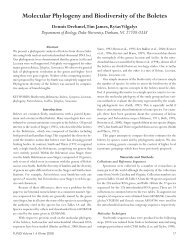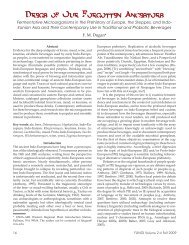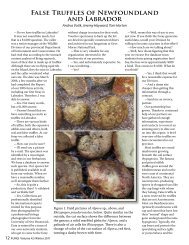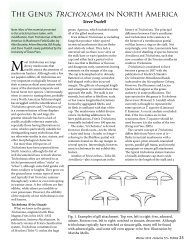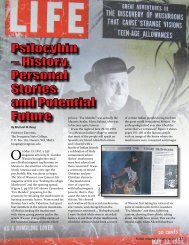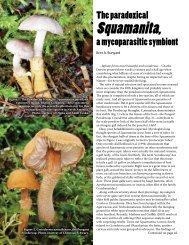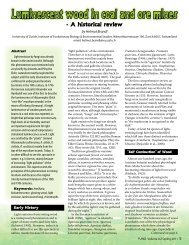Notes from Under- ground - FUNGI Magazine
Notes from Under- ground - FUNGI Magazine
Notes from Under- ground - FUNGI Magazine
You also want an ePaper? Increase the reach of your titles
YUMPU automatically turns print PDFs into web optimized ePapers that Google loves.
tion of dreams, madness, and the supernatural. The proto-surrealist<br />
Lautreamont developed a bestiary of menacing fauna in Les<br />
Chants de Maldoror that would parallel the Darwinian vision of nature<br />
in endless flux and transformation, while Nathaniel Hawthorne<br />
personified toxic principles of plant life in his disarming<br />
story “Rappaccini’s Daughter.” As astronomical discovery conjured<br />
the possibility of space travel and writers like Jules Verne and<br />
H. G. Wells gave voice to the dilemmas and insecurities of science<br />
and technology through speculative fiction, “science fiction” proper<br />
then began its career as the twentieth century’s most notable genre<br />
of outsider literature. The War of the Worlds (1898) endures as the<br />
paradigmatic tale of alien invasion, but Wells also explored genetic<br />
experimentation, limned with the fungoid trappings of a strange<br />
jungle environment, in The Island of Dr. Moreau and constructed<br />
his story “The Purple Pileus” on the premise that fungi have the<br />
power to alter human destiny. After World War II, the themes of<br />
invasion and colonization by alien life-forms characterized countless<br />
works of science fiction, and the role of mushrooms and myxomycetes<br />
in this is considerable: Eleanor Cameron’s The Wonderful<br />
Flight to the Mushroom Planet (1954), John Wyndham’s Trouble with<br />
Lichen (1960), Philip K. Dick’s Clans of the Alphane Moon (1964),<br />
Ray Bradbury’s story “Boys! raise giant mushrooms in your cellar!”<br />
(1964), Piers Anthony’s Omnivore (1968), Harry Adam<br />
Knight’s The Fungus (1989), Bernard Werber’s Empire of the Ants<br />
(1991), Elizabeth Hand’s Icarus Descending (1993), and Jeff<br />
VanderMeer’s City of Saints and Madmen (2002) are all works of<br />
visionary, mycological, science fiction. Fungal themes palpitate<br />
in cult classics of cinema like The Blob (1958) and Matango: Attack<br />
of the Mushroom People (1963), and even mycologists have turned<br />
their spore prints into fairy tales: witness the fiction of mycologist<br />
E. C. Large or Louis C. C. Krieger’s fantasy, “The Millenium<br />
of Systematic Mycology.” These works have antecedents in a deeper<br />
literary tradition, and though it exceeds the scope of this study to<br />
trace the subject exhaustively back to the dawn of literature, a<br />
few early cases deserve mention.<br />
Cryptogamic Biomorphism<br />
The Greek satirist Lucian (ca.117–ca.180) wrote humorous<br />
dialogues that exposed the classic philosophers to ridicule, and<br />
his True History is a wildly fantastic adventure that numbers among<br />
its descendants Gargantua and Pantagruel of Rabelais, More’s Utopia,<br />
Swift’s Gulliver’s Travels, and H. G. Wells’s The First Men in the<br />
Moon. A more ridiculously ironic title cannot be imagined, for the<br />
True History is anything but true, dealing as it does with rivers of<br />
wine, flying islands, biomorphic tree-people, and birds with wings<br />
of lettuce. Mushrooms enter the narrative in a description of a<br />
fantastic war prosecuted by the king of the moon:<br />
Next to the mercenaries were about ten thousand Mushroom<br />
Commandoes, heavy-armed troops trained for<br />
hand-to-hand fighting who used mushrooms as shields<br />
and asparagus stalks as spears; and next to them again<br />
were five thousand Bow-wows <strong>from</strong> Sirius. These were<br />
dog-faced human beings mounted on flying chestnuts. 3<br />
The True History revels in a mulligatawny of biomorphic forms<br />
and processes, and Lucian’s bizarre notion of reproduction among<br />
the “tree-men” recalls fungal morphology, suspiciously close to<br />
the gasteromycetes:<br />
Even more surprising is the method of propagating what<br />
are known as Tree-men. This is how it’s done: you cut off<br />
the father’s right testicle and plant it in the <strong>ground</strong>, where<br />
it grows into a large fleshy tree rather like a phallus, except<br />
that it has leaves and branches and bears fruit in the<br />
form of acorns, which are about eighteen inches long.<br />
When the fruit is ripe, it is picked and the babies inside<br />
are hatched out. 4<br />
Although mushrooms, particularly Amanita caesarea and<br />
boletes, were eaten and appreciated in the ancient world, it was<br />
not until centuries later that they began to appear in botanical<br />
herbals, and subsequently in works of imaginative literature.<br />
Gargantua and Pantagruel by François Rabelais (ca. 1494–1553)<br />
commands our attention; famous for its depiction of the weed<br />
“Pantagruelion” (Cannabis sativa), it bears the fantastic stamp of<br />
the True History with a superadded cornucopia of vegetation, ribaldry,<br />
nonsense, gluttony, and scholarship both medical and theological.<br />
Training a botanical eye upon this masterpiece serves to<br />
contextualize it as a kind of herbal encyclopedia that includes a<br />
host of vegetable products and medicinal plants: saffron, thistle,<br />
hellebore, henbane, moss, euphorbium, leeks, quince, rhubarb,<br />
cassia, mandrake, and many more. Rabelais had a mania for listing;<br />
interpolated lists form part of the narrative structure. The<br />
Rabelaisian list of the known mycological world includes agarics,<br />
lichens, morels, tree ear, and toadstools; in addition, he brings an<br />
incipient understanding of mycological phenomena like fermentation,<br />
human parasites (“ringbone” or ringworm), mycorrhizae<br />
(a tree “that nourishes the good agaric on its roots”), and, above<br />
all, Saint Anthony’s fire, the gangrenous disease caused by ergot<br />
(Claviceps purpurea), the curse of the Middle Ages. Rhizotome is a<br />
young page in charge of Gargantua’s botanical education, and Lent<br />
is a monstrous character whose chin is formed of mushrooms and<br />
who defecates toadstools and morels. These fantastic elements<br />
generate an explosive proliferation of botanical and mycological<br />
entities in the somatic cosmos of gargantuan characters and cataclysmic<br />
events, for these people are truly giants. Fungi play a critical<br />
role both as the “food of the gods” and as mysterious subterranean<br />
and subcutaneous forces in the “Gaia Hypothesis” of Rabelais’s<br />
world, and one may easily imagine the devilish Boletus satanus si-<br />
22 <strong>FUNGI</strong> Volume 2:1 Spring 2009



